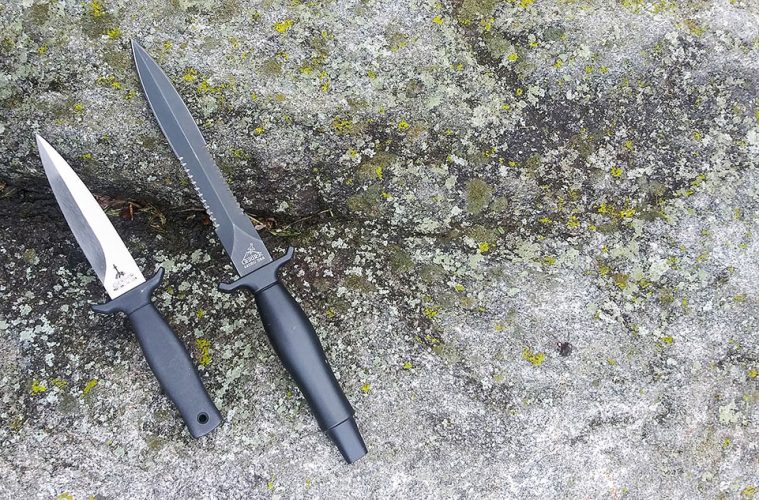HISTORIC BLADES: REMEMBERING GERBER’S ICONIC MARK 1 AND MARK II
It was right after Christmas, 1983. I was a newly minted teenager, and for some reason lost to the mists of time, I’d gone with my mother to the Mayfair Mall. We didn’t go there often, as it was the mall that was farthest from home, but whenever we did, I made sure to stop in and check out the wares at Cutlery World.
“From the jungles of Vietnam to the belts and boots of countless civilians across the country, these knives have seen plenty of carry time.”
It was fairly small as far as mall stores went, but it had all sorts of sharp and pokey goodies. On this particular trip, I found a boot knife called the Mark 1. It was double-edged, quite sharp, and I was hopelessly smitten with it. If memory serves, sticker price was around $50 or so. For perspective, that’s about $140 today. To this day, I don’t know how I did it, but I managed to convince my mom to loan me the money to buy it. Well, she actually bought it, given that they weren’t about to sell a dagger like that to a 13-year-old kid.
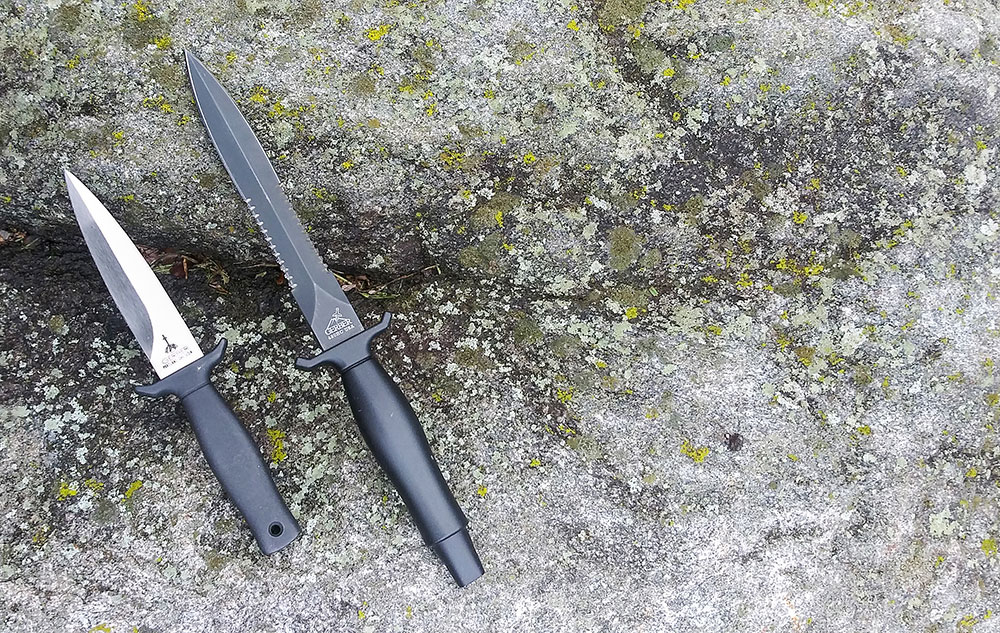
There’s no denying the impact the Gerber Mark 1 and Mark II have had on the knife industry over the years. Author photo.
When school started up after the holiday break, my mom gave me explicit instructions that the dagger was not to leave the house. First day back, I was called into the office to speak with her on the phone. Seems she’d checked my room and found that the knife was missing, and then called the school to talk to me. I knew right where it was, secure in my right boot, having just replaced it there after showing the knife to a couple of friends in the bathroom. I caught hell for that stunt, but thankfully the school never found out. Today, that would likely be an expulsion-level offense.
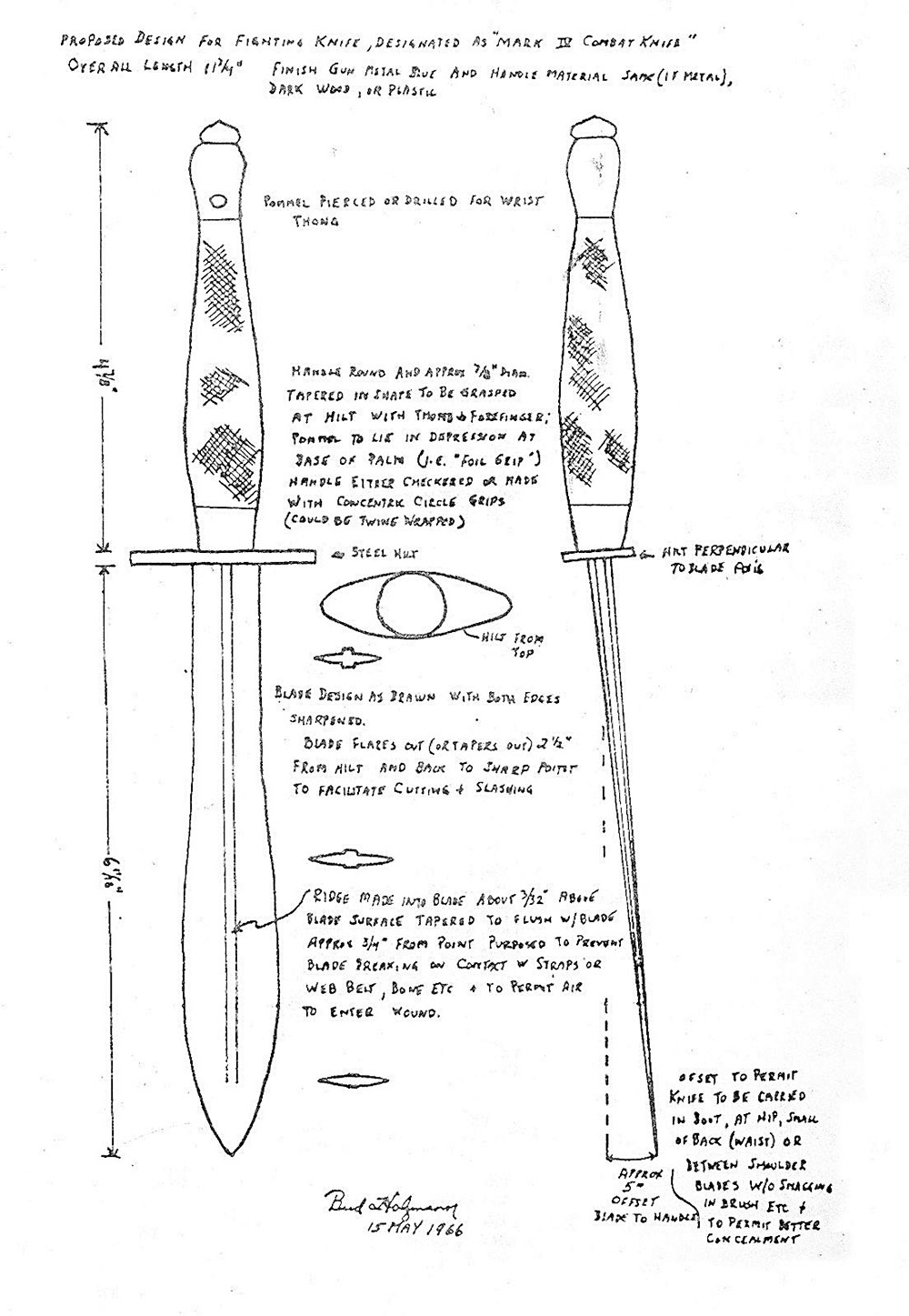
This is part of the initial design artwork created by Bud Holzmann and submitted to Gerber. Mark Holzmann photo.
Thus was my introduction to the iconic Gerber daggers. A buddy of mine lost that knife for me a few years later while we were hiking, but I’ll never forget how cool the dagger was. Let’s take a look at the history of the Mark 1 and Mark II, two legendary knives.
Mark II
Clarence “Bud” Holzmann was a U.S. Army Captain with the 101st Airborne during World War II. He earned the Bronze Star for gallantry under enemy fire. After retiring from military service, he and his wife lived in Portland, Oregon, and he worked in automotive sales. Several years later, in the 1960s, he began designing a combat knife. He wanted to create something suitable for U.S. troops to use in Vietnam.
Patterned loosely after another legendary knife, the Fairbairn-Sykes dagger, he gave the knife a wasp-waisted blade that was double-edged and deadly. The handle was oval, rather than round like the F-S dagger, which allowed for easier indexing in the hand.
He presented the design to Gerber Legendary Blades in May 1966. By July, a prototype had been made and sent to Fort Lewis for testing and evaluation. The feedback received was used to modify the design and a second prototype was sent out. By 1967, the Gerber Mark II was in production.
It was never officially issued to U.S. troops in Vietnam, but it was available for purchase through base PXs. The Mark II became popular with what we might call the special warfare community, particularly those in the MACV SOG units. However, in the 1970s the knife was seen as being too brutal in appearance and was pulled from base distribution. Gerber countered by adding sawtooth serrations to the blade, and then marketing it as a survival knife rather than specifically for combat. With these changes, the PX system began selling it again.
By 1998, the knife’s popularity had declined, as had the sales numbers, and the Mark II was discontinued. However, after an onslaught of customer requests, the knife was put back into production in 2008.
Bud Holzmann passed away on April 27, 2010, surrounded by family. He was buried with full military honors in Oregon, at Willamette National Cemetery. His knife design remains one of the most famous ever produced.
Mark II Design
The Mark II is characterized by the long, double-edged blade, topping out at 6.625 inches from guard to point. It narrows slightly near the middle, giving it its distinctive wasp-waist profile. A cross-section of the blade looks like a narrow diamond.
The handle is cast aluminum, all one piece, with some versions of the knife having what came to be called “cat’s tongue” texturing. To provide for a positive, secure grip in challenging conditions, such as with wet hands, part of the production process involved spraying the aluminum handles with molten steel. The steel would slightly melt the aluminum and bond with it, creating a non-slip surface.
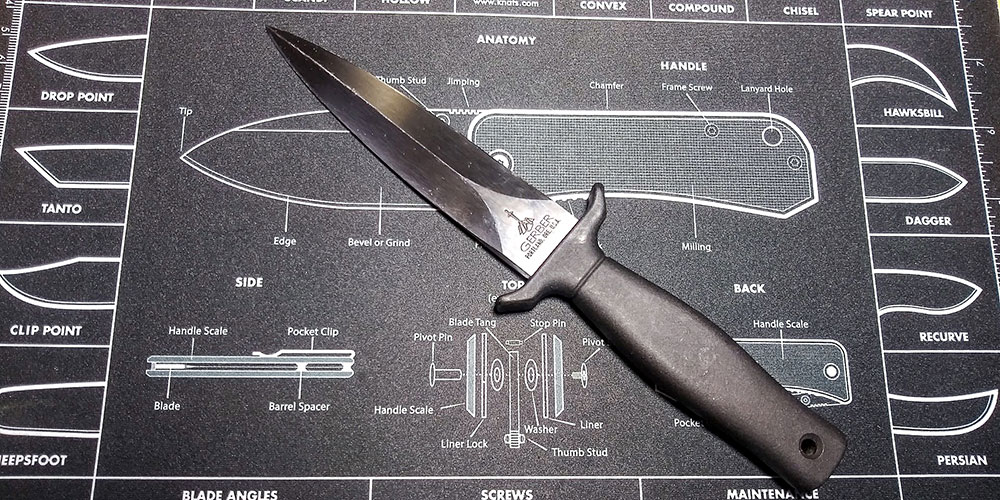
A dagger has but one real purpose, and it isn’t carving sticks or making emergency shelters. Author photo.
This was used on the early editions of the knife and then in a few special runs later. The remainder had Armorhide applied to the handles, which served a similar purpose, and ran from gray (1968-1977) to black (1977-present). There were a few limited runs in yellow and orange as well.
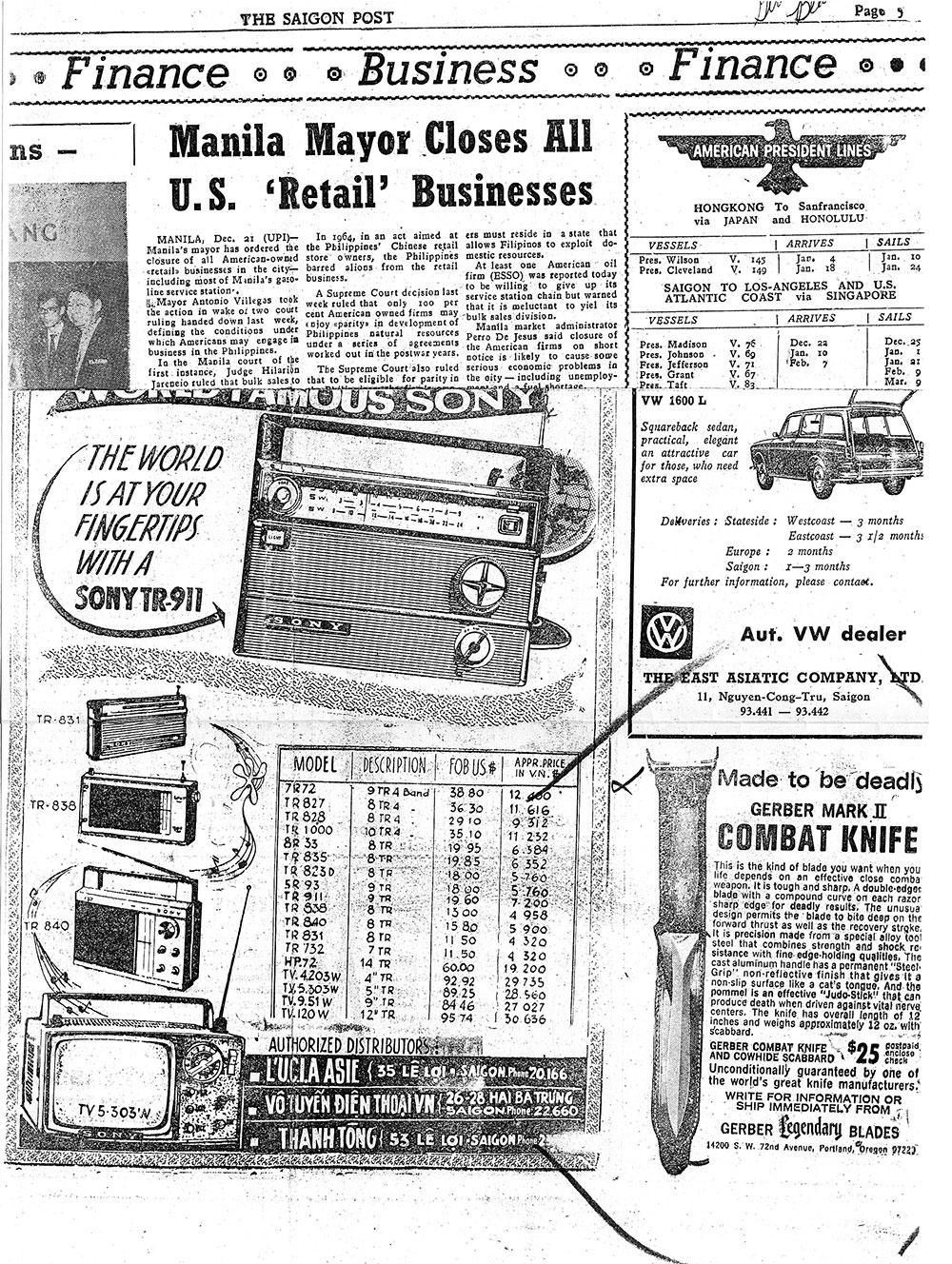
This is an ad that ran in the Saigon Post, circa 1966 or so, showing the Gerber Mark II, proclaiming it to be, “Made to be deadly.” Doug Hutchens photo.
Originally, the blades were made from L6 steel. This is a high carbon steel, which worked great but, like all high carbon steel, could be prone to rust or corrosion. Gerber switched to 440C stainless steel in 1982 and eventually produced some models in 420C as well.
Over the years, both serrated and non-serrated models were made, but the sawtooth ones appear to be the most common found today.
Mark II in the Media
The Mark II has been a fairly popular blade in Hollywood. Remember the scene in “Aliens” when Lance Bishop, the android played by Lance Henriksen, grabbed Private Hudson’s (Bill Paxton) hand and played the knife game, poking the knife back and forth between his fingers?
A few years prior, the Mark II’s handle was seen poking out from Max’s (Mel Gibson) boot in “The Road Warrior.”
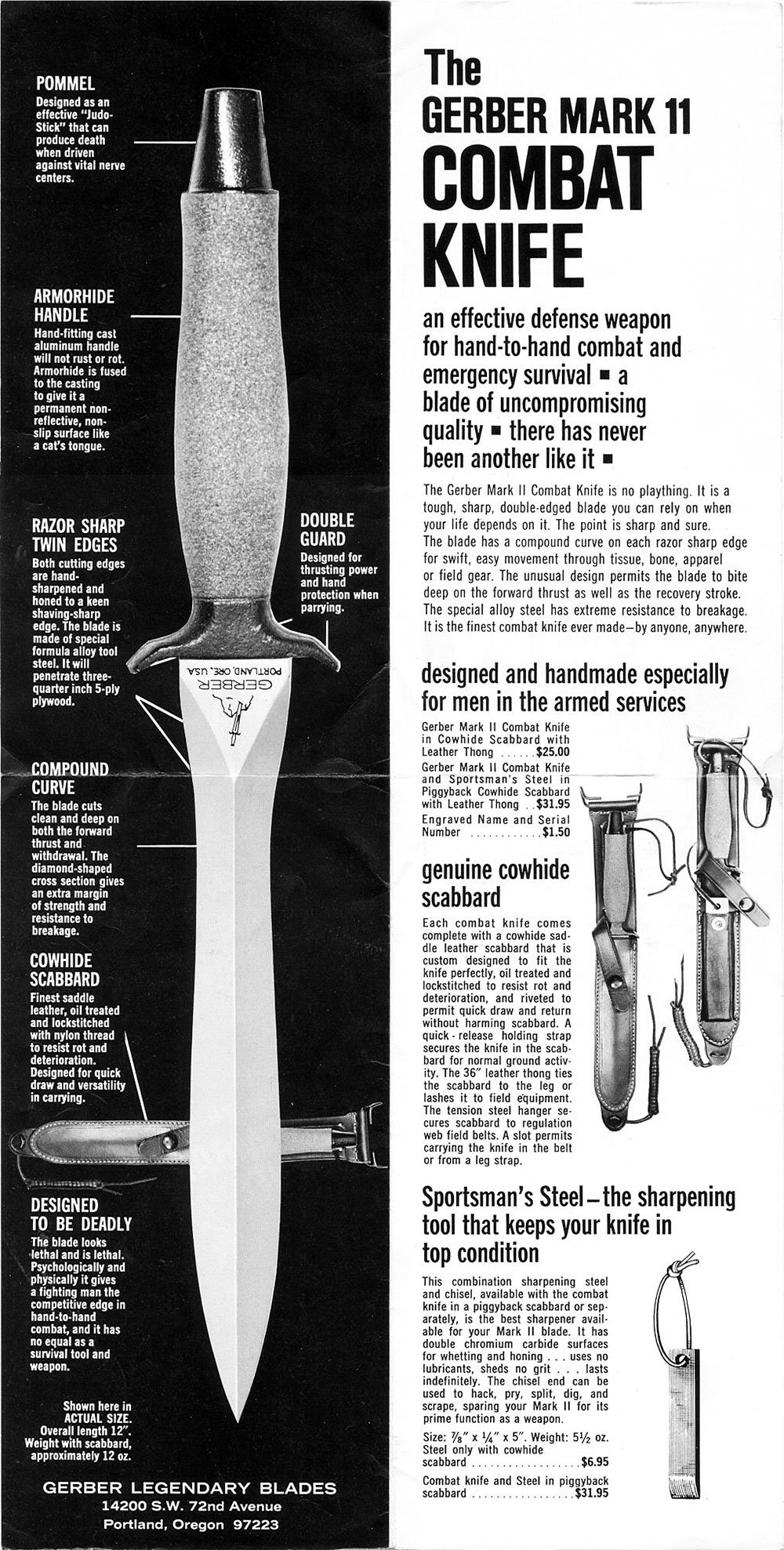
This is from a small folder printed and distributed by Gerber advertising the Mark II as a combat knife. Gerber Legendary Blades photo.
In 1992, Casey Ryback, played by Steven Seagal, used one in his final battle against William Strannix (Tommy Lee Jones) in “Under Siege.” More recently, the Winter Soldier (Sebastian Stan) used one while fighting Captain America (Chris Evans) in the aptly titled “Captain America: The Winter Soldier.”
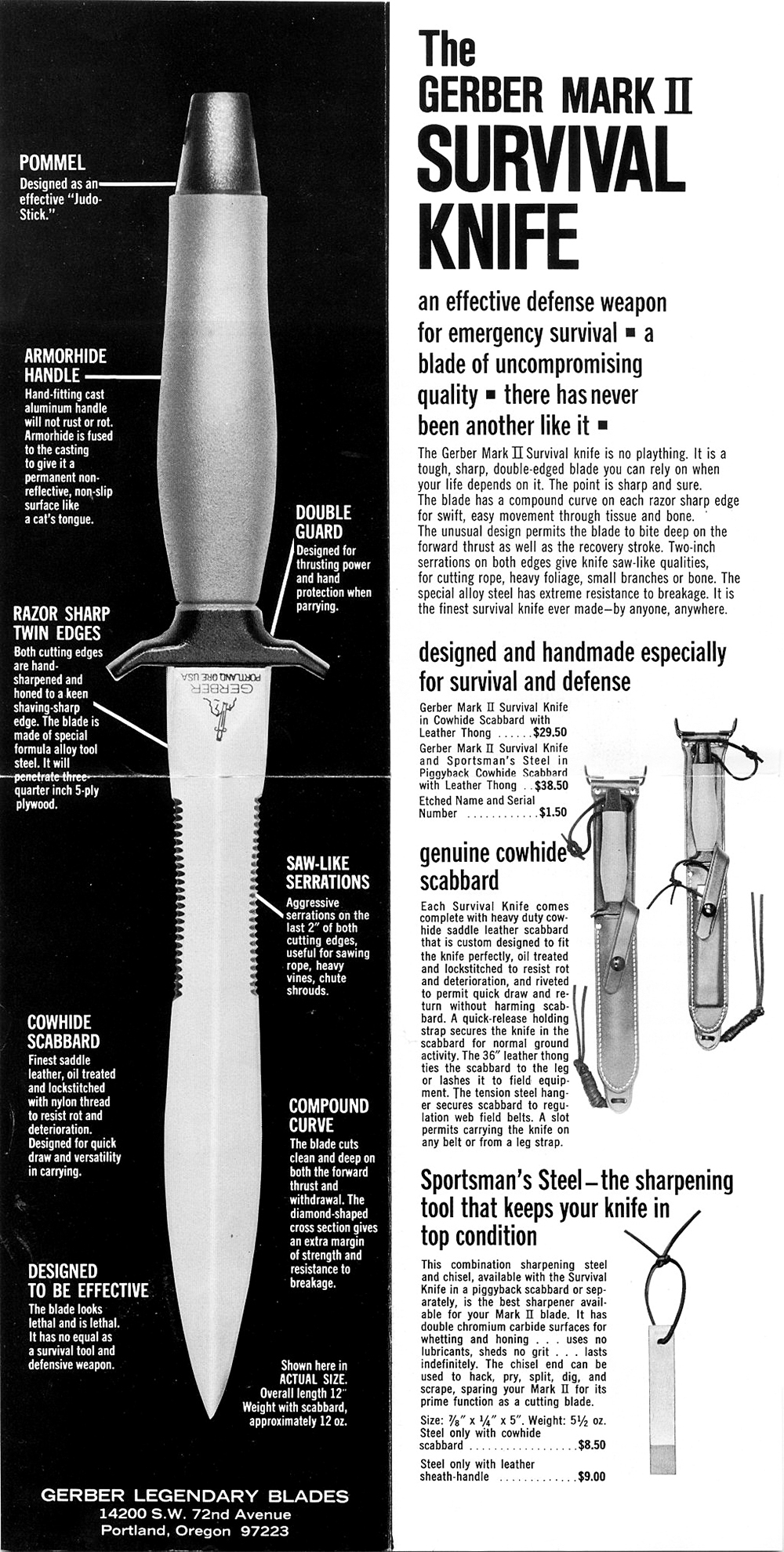
This folder was produced by Gerber beginning in 1972, changing the advertising angle from a combat knife to a survival tool. Gerber Legendary Blades photo.
Over in the literary world, the Mark II was the dagger recommended in the 1983 book “Hit Man” by Rex Feral. Ostensibly written by a professional assassin, who turned out to be a woman who’d cobbled information together from TV shows, movies, and novels, the book was eventually pulled from publication after the publisher, Paladin Press, became embroiled in lawsuits due to a triple murder that occurred in 1993.
Paul Rubenstein, sidekick to hero John Thomas Rourke in the “Survivalist” series written by Jerry and Sharon Ahern, was given a Mark II by Rourke.
Mark 1
The Mark 1 came after the Mark II, despite the numbering. The intention was to create a knife that was legal to carry in more places than the Mark II. It seems that a 6-inch double-edged dagger wasn’t allowed in many areas.
To meet consumer requests, Gerber created a smaller dagger called the Mark 1. Not only did the company’s designers shorten the blade, but they also reconfigured the handle a bit. It came with a leather sheath that was outfitted with a clip designed for boot carry.
“…the knife was seen as being too brutal in appearance…Gerber countered by adding sawtooth serrations…then marketing it as a survival knife…”

This is Master Sergeant Jerry Michael Shriver, CCS, MACV-SOG (5th Special Forces Group). You can see the Mark II carried in an inverted position on his left side. Jim Fleming photo.
The Mark 1 went into production in 1976. It was made in a couple of different configurations over the years and finally discontinued in 1997.
In a further attempt to create a dagger that wouldn’t get customers into trouble with the law, they came out with the Command 1 in late 1979. Almost identical to the Mark 1 in size and shape, it differed in one important way. Instead of both edges being sharpened, the Command 1 had one edge fully sharp and the other side had the top third of the edge serrated. This was enough of a change to make the Command 1 legal in many areas where a fully double-edged dagger was forbidden.
The Command 1 was in production until 1994. Like the Mark 1, there were a few variations along the way, primarily regarding the steel used.
Mark 1 Design
The Mark 1 is a double-edged dagger, with a blade running 4.75 to 5 inches in length, depending upon the year of production, and an overall length of about 9 inches. From 1976 to 1981, the blade was L6 high carbon steel, just like the Mark II. At that point, the company moved to using 440C stainless steel. The Command 1 was only made with the 440C stainless steel.
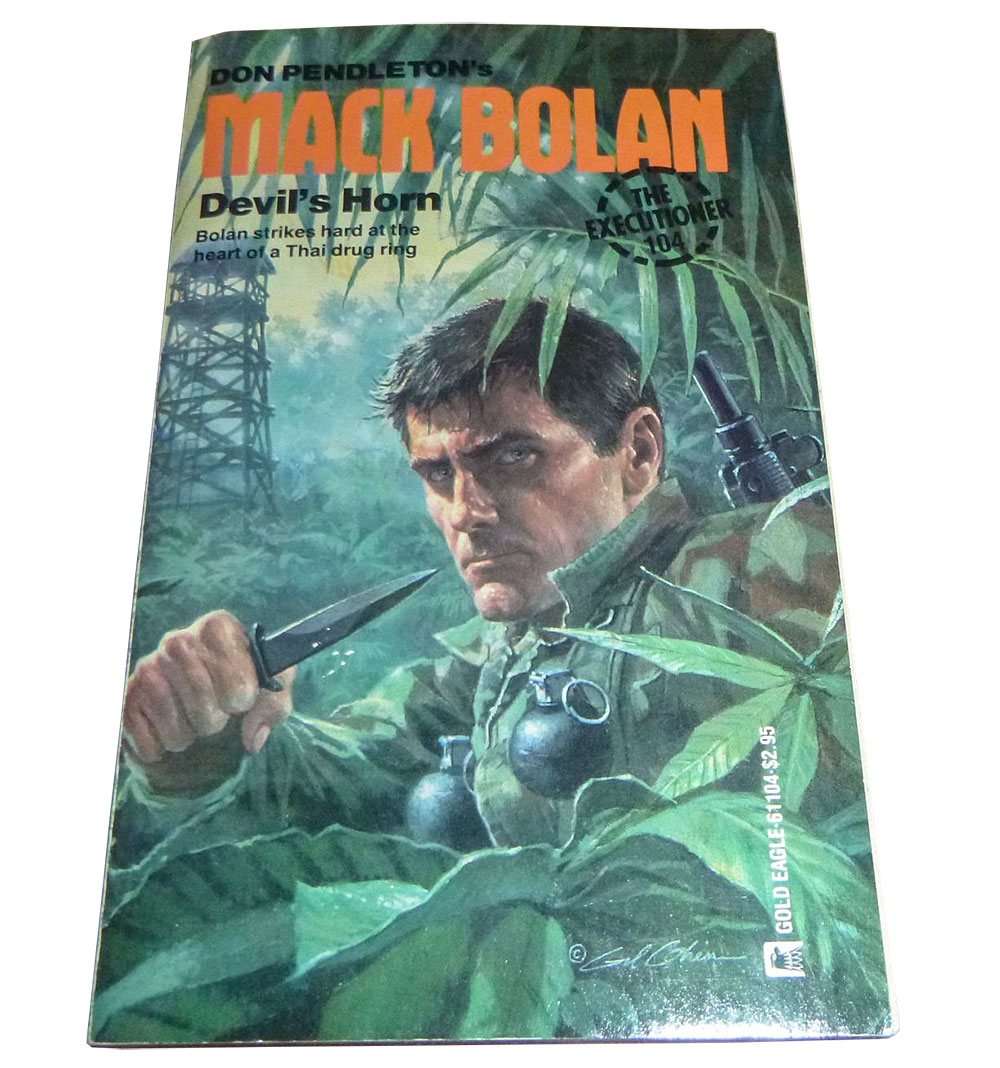
The cover of Executioner #104 showing the main character, Mack Bolan, with what appears to be a Mark 1 dagger in his hand. Tony Bacon photo.
The aluminum handle is 4 inches long. It is one piece and features a lanyard hole at the base.
Mark 1 in the Media
The Mark 1 hasn’t seen nearly as much screen time as its older brother, but super spy James Bond used one in 1997’s “Tomorrow Never Dies.” Despite a very similar appearance, the knife used by Jack Burton (Kurt Russell) in “Big Trouble in Little China” was not a Mark 1, but a modified Gerber Tac II.
Mack Bolan, vigilante hero of hundreds of novels, holds a Mark 1 on the cover of “The Executioner #104—Devil’s Horn.”
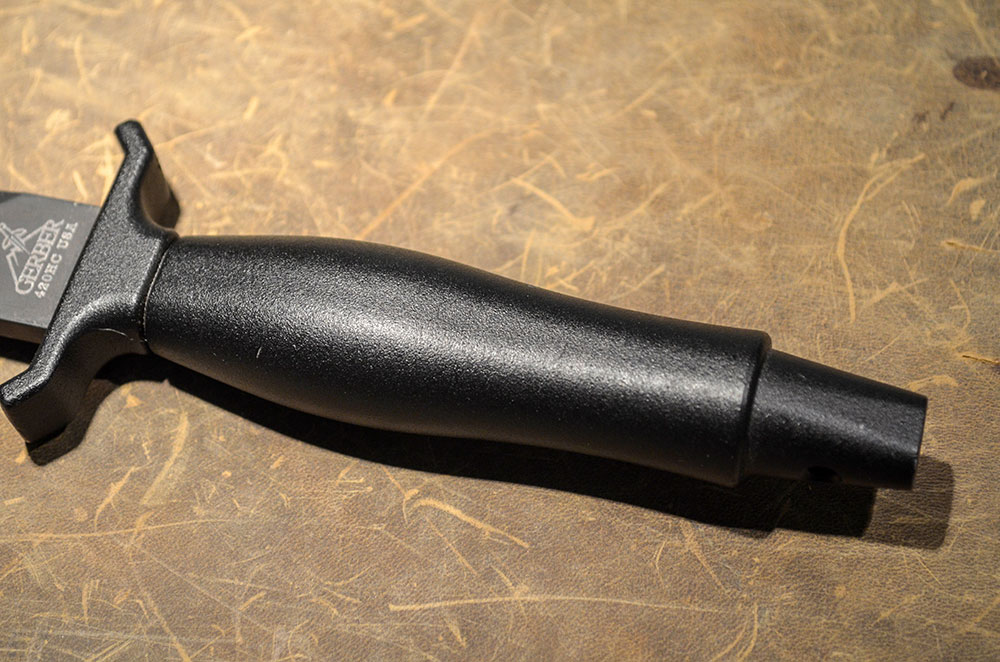
The aluminum handle on the Mark II is contoured and slightly oval-shaped. Author photo.
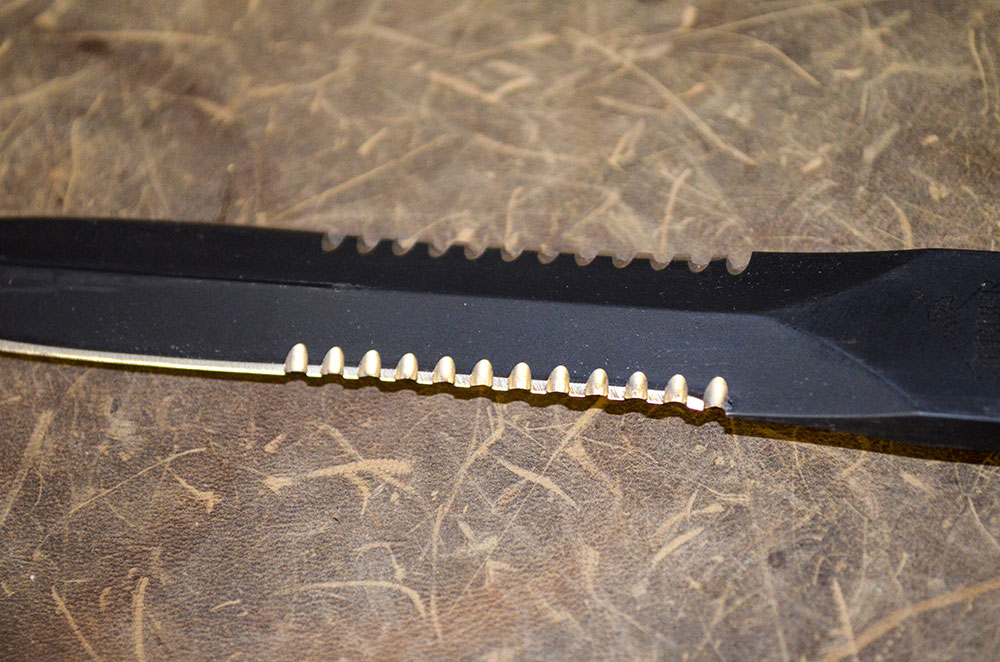
The saw teeth on the Mark II aren’t all that functional, to be honest. Author photo.
Both the Mark 1 and the Mark II were often imitated. Based strictly upon my own experience, the Mark 1 in particular was one of the most cloned knives I’ve ever seen. Seemingly every flea market and pawn shop in the 1980s was rife with Mark 1 knockoffs. Most of them made overseas, no doubt, and all of them of dubious quality. Of course, when we were kids, we didn’t know much better and bought them by the dozen.
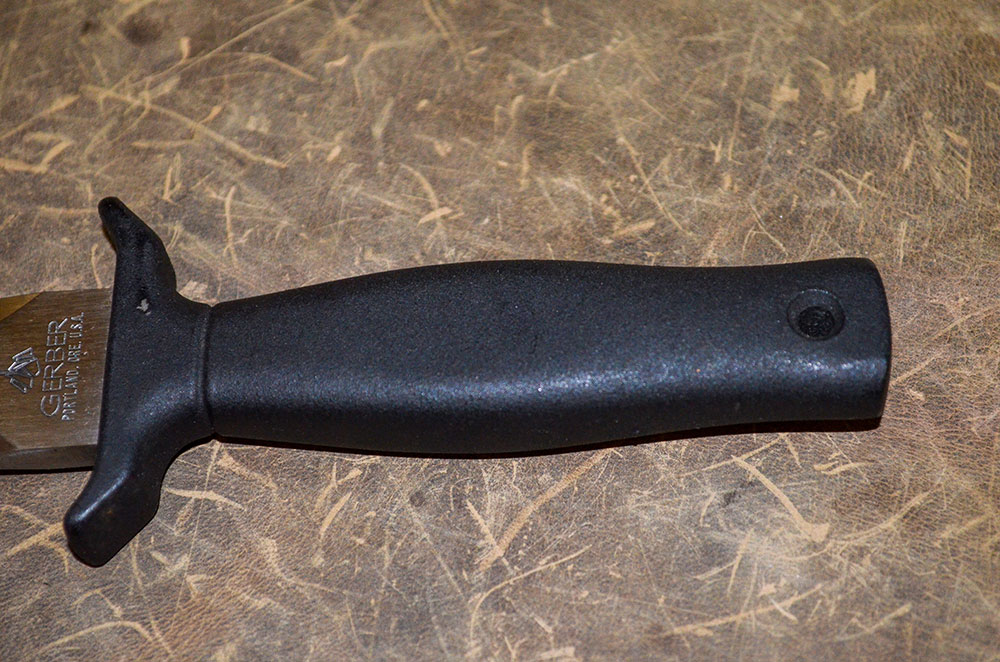
As with the Mark II, the Mark 1’s handle has some texturing to help maintain your grip. Author photo.
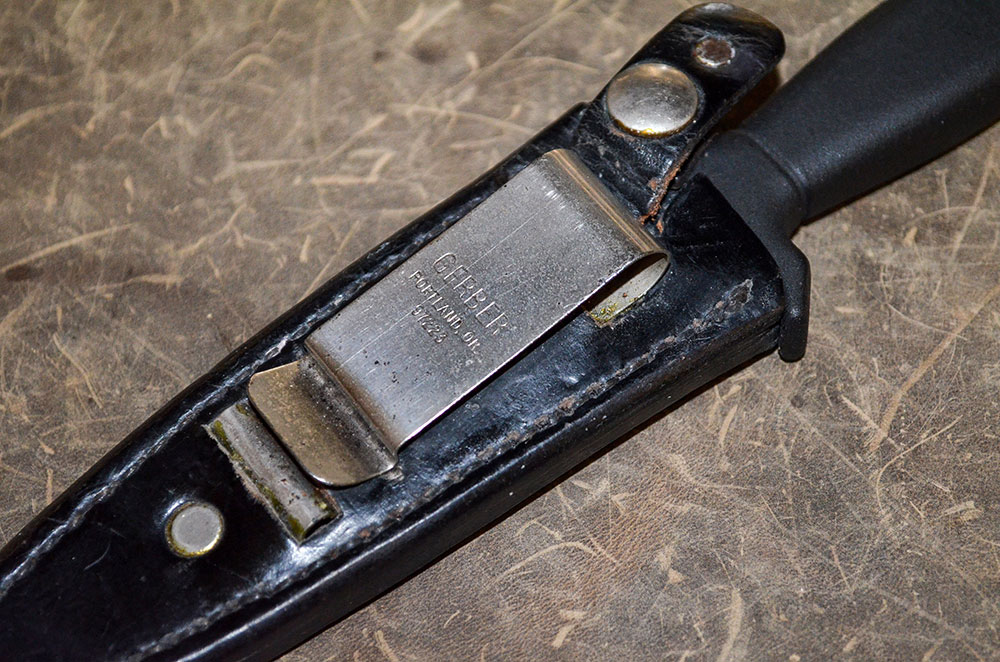
Marketed as a boot knife, the Mark 1 has a clip rather than a belt loop on the sheath. Author photo.
From the jungles of Vietnam to the belts and boots of countless civilians across the country, these knives have seen plenty of carry time. Every knife has a purpose, and while a double-edged dagger’s raison d’etre isn’t exactly bushcraft or food prep, there’s no denying the impact the Gerber Mark 1 and Mark II have had on the knife industry over the years.
(Author’s note: Special thanks to John Sabol, Angelo Semiforo, and Mike Stewart for their help with research for this article.)
EARLY RUN WITH CANTED BLADES
The first run of the Mark II back in 1967 had a blade that was canted at about a 5-degree angle from the handle This was a design feature that served multiple purposes. First, it was to keep the handle bent slightly away from the body when in a belt sheath, both for comfort as well as making the knife easier to deploy quickly. Second, when the knife was in the hand, the blade would be angled upward, something similar to a fencing foil.
However, Gerber received many complaints from customers who bought the knife and then wanted to return it because they thought the blade was bent and thus defective. So, they discontinued the canted design and moved forward with just keeping the blades straight.
MilitaryCarryKnives.com for All the Details
John Sabol has put together an outstanding resource on the Gerber Mark II knife. Online since 2008, this site contains hundreds of photos of these knives, documenting the myriad variations produced over the years. Countless hours were spent compiling information from a wide range of sources to provide a one-stop-shop for information. The site is easy to navigate and loaded with details.
A version of this article first appeared in the May/June 2022 print issue of Knives Illustrated.

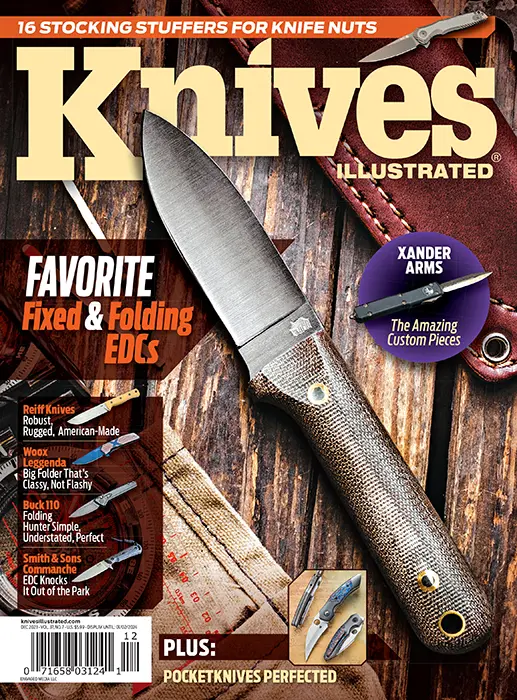 Subscribe / Back Issues
Subscribe / Back Issues